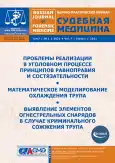Mathematical modeling of the corpse cooling under conditions of varying ambient temperature
- 作者: Nedugov G.V.1
-
隶属关系:
- Samara State Medical University
- 期: 卷 7, 编号 1 (2021)
- 页面: 29-35
- 栏目: 原创研究
- URL: https://journals.rcsi.science/2411-8729/article/view/122408
- DOI: https://doi.org/10.17816/fm360
- ID: 122408
如何引用文章
全文:
详细
Background: The constancy of the ambient temperature is the main condition to correctly determine the time of death by thermometric method. However, in practice, this requirement is met only in cases of death in closed rooms. In this study, an exponential mathematical model was proposed for corpse cooling under any changes in ambient temperature. Aim: This study aimed to develop a mathematical model to determine the time of death based on the Newton–Richman cooling law in changing ambient temperature conditions. Materials and methods: Mathematical modeling of corpse cooling under changing ambient temperature is performed, focusing on problem solving of thermometric determination of the time of death. The axillary hollow was used as the diagnostic zone of the corpse, and the temperature of which at the time of death is taken is 36.6°С. Results: A method of reverse reproduction of the cadaver temperature in conditions of changing ambient temperature has been developed. Results allow a relatively simple analytical determination of the time of death in the early postmortem period. Conclusions: The proposed method is advisable to be used in forensic medical practice to determine the time of death in early postmortem period. The developed mathematical model is implemented in the format of the application program Warm Bodies NRN. Use of tympanic and intraocular thermometry was recommended within the proposed model.
作者简介
German Nedugov
Samara State Medical University
编辑信件的主要联系方式.
Email: nedugovh@mail.ru
ORCID iD: 0000-0002-7380-3766
SPIN 代码: 3828-8091
Scopus 作者 ID: 25947646500
Cand. Sci. (Med.), Assistant Professor
俄罗斯联邦, Samara参考
- Wilk LS, Hoveling RJ, Edelman GJ, et al. Reconstructing the time since death using noninvasive thermometry and numerical analysis. Sci Adv. 2020;6(22):eaba4243. doi: 10.1126/sciadv.aba4243
- Hubig M, Muggenthaler H, Mall G. Confidence intervals in temperature-based death time determination. Leg Med (Tokyo). 2015;17(1):48–51. doi: 10.1016/j.legalmed.2014.08.002
- Shved AF, Vavilov AJu. Technique of the automated search the moment of the beginning of process of postmortal coolings (time of death) with use the standard tabulared processor Microsoft® Office Excel. Problemy ekspertizy v meditsine. 2005;5(3):36–39. (In Russ).
- Davidzon MI. O zakone okhlazhdeniya N’yutona-Rikhmana. Vestnik Ivanovskogo gosudarstvennogo universiteta. Estestvennye, obshchestvennye nauki. 2010;(2):70–75. (In Russ).
- Kaliszan M, Hauser R, Kernbach-Wighton G. Estimation of the time of death based on the assessment of post mortem processes with emphasis on body cooling. Leg Med (Tokyo). 2009;11(3):111–117. doi: 10.1016/j.legalmed.2008.12.002
- Rainy H. On the cooling of dead bodies as indicating the length of time that has elapsed since death. Glasgow Med J. 1869;1(3):323–330.
- Kuzovkov AV, Vavilov AYu. Diagnostics of prescription of death of the person in the early posthumous period in the noninvasive thermometric way. Problemy ekspertizy v meditsine. 2014;14 (4):24–27. (In Russ).
- Kaliszan M, Hauser R, Kaliszan R, et al. Verification of the exponential model of body temperature decrease after death in pigs. Exp Physiol. 2005;90(5):727–738. doi: 10.1113/expphysiol.2005.030551
补充文件







